Yiren Zhao
On the Existence and Behaviour of Secondary Attention Sinks
Dec 22, 2025Abstract:Attention sinks are tokens, often the beginning-of-sequence (BOS) token, that receive disproportionately high attention despite limited semantic relevance. In this work, we identify a class of attention sinks, which we term secondary sinks, that differ fundamentally from the sinks studied in prior works, which we term primary sinks. While prior works have identified that tokens other than BOS can sometimes become sinks, they were found to exhibit properties analogous to the BOS token. Specifically, they emerge at the same layer, persist throughout the network and draw a large amount of attention mass. Whereas, we find the existence of secondary sinks that arise primarily in middle layers and can persist for a variable number of layers, and draw a smaller, but still significant, amount of attention mass. Through extensive experiments across 11 model families, we analyze where these secondary sinks appear, their properties, how they are formed, and their impact on the attention mechanism. Specifically, we show that: (1) these sinks are formed by specific middle-layer MLP modules; these MLPs map token representations to vectors that align with the direction of the primary sink of that layer. (2) The $\ell_2$-norm of these vectors determines the sink score of the secondary sink, and also the number of layers it lasts for, thereby leading to different impacts on the attention mechanisms accordingly. (3) The primary sink weakens in middle layers, coinciding with the emergence of secondary sinks. We observe that in larger-scale models, the location and lifetime of the sinks, together referred to as sink levels, appear in a more deterministic and frequent manner. Specifically, we identify three sink levels in QwQ-32B and six levels in Qwen3-14B.
Mixture of Weight-shared Heterogeneous Group Attention Experts for Dynamic Token-wise KV Optimization
Jun 16, 2025
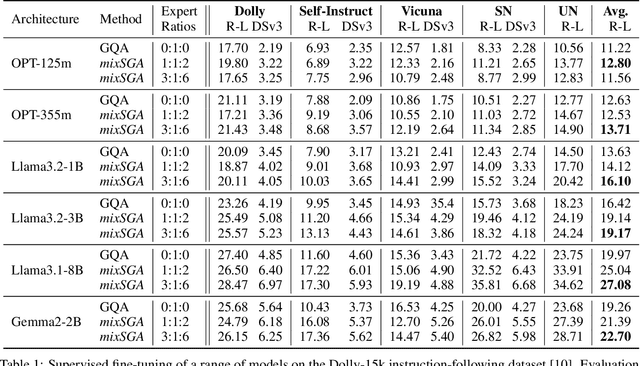
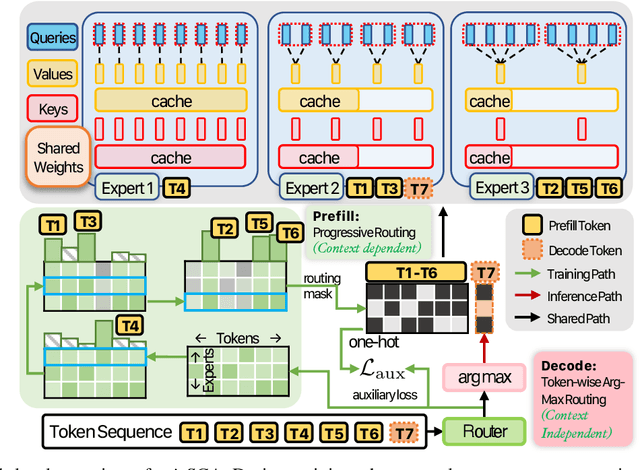

Abstract:Transformer models face scalability challenges in causal language modeling (CLM) due to inefficient memory allocation for growing key-value (KV) caches, which strains compute and storage resources. Existing methods like Grouped Query Attention (GQA) and token-level KV optimization improve efficiency but rely on rigid resource allocation, often discarding "low-priority" tokens or statically grouping them, failing to address the dynamic spectrum of token importance. We propose mixSGA, a novel mixture-of-expert (MoE) approach that dynamically optimizes token-wise computation and memory allocation. Unlike prior approaches, mixSGA retains all tokens while adaptively routing them to specialized experts with varying KV group sizes, balancing granularity and efficiency. Our key novelties include: (1) a token-wise expert-choice routing mechanism guided by learned importance scores, enabling proportional resource allocation without token discard; (2) weight-sharing across grouped attention projections to minimize parameter overhead; and (3) an auxiliary loss to ensure one-hot routing decisions for training-inference consistency in CLMs. Extensive evaluations across Llama3, TinyLlama, OPT, and Gemma2 model families show mixSGA's superiority over static baselines. On instruction-following and continued pretraining tasks, mixSGA achieves higher ROUGE-L and lower perplexity under the same KV budgets.
A3 : an Analytical Low-Rank Approximation Framework for Attention
May 19, 2025Abstract:Large language models have demonstrated remarkable performance; however, their massive parameter counts make deployment highly expensive. Low-rank approximation offers a promising compression solution, yet existing approaches have two main limitations: (1) They focus on minimizing the output error of individual linear layers, without considering the architectural characteristics of Transformers, and (2) they decompose a large weight matrix into two small low-rank matrices. Consequently, these methods often fall short compared to other compression techniques like pruning and quantization, and introduce runtime overhead such as the extra GEMM kernel launches for decomposed small matrices. To address these limitations, we propose $\tt A^\tt 3$, a post-training low-rank approximation framework. $\tt A^\tt 3$ splits a Transformer layer into three functional components, namely $\tt QK$, $\tt OV$, and $\tt MLP$. For each component, $\tt A^\tt 3$ provides an analytical solution that reduces the hidden dimension size inside each component while minimizing the component's functional loss ($\it i.e.$, error in attention scores, attention outputs, and MLP outputs). This approach directly reduces model sizes, KV cache sizes, and FLOPs without introducing any runtime overheads. In addition, it provides a new narrative in advancing the optimization problem from singular linear layer loss optimization toward improved end-to-end performance. Through extensive experiments, we show that $\tt A^\tt 3$ maintains superior performance compared to SoTAs. For example, under the same reduction budget in computation and memory, our low-rank approximated LLaMA 3.1-70B achieves a perplexity of 4.69 on WikiText-2, outperforming the previous SoTA's 7.87 by 3.18. We also demonstrate the versatility of $\tt A^\tt 3$, including KV cache compression, quantization, and mixed-rank assignments for enhanced performance.
ARIES: Autonomous Reasoning with LLMs on Interactive Thought Graph Environments
Feb 28, 2025



Abstract:Recent research has shown that LLM performance on reasoning tasks can be enhanced by scaling test-time compute. One promising approach, particularly with decomposable problems, involves arranging intermediate solutions as a graph on which transformations are performed to explore the solution space. However, prior works rely on pre-determined, task-specific transformation schedules which are subject to a set of searched hyperparameters. In this work, we view thought graph transformations as actions in a Markov decision process, and implement policy agents to drive effective action policies for the underlying reasoning LLM agent. In particular, we investigate the ability for another LLM to act as a policy agent on thought graph environments and introduce ARIES, a multi-agent architecture for reasoning with LLMs. In ARIES, reasoning LLM agents solve decomposed subproblems, while policy LLM agents maintain visibility of the thought graph states, and dynamically adapt the problem-solving strategy. Through extensive experiments, we observe that using off-the-shelf LLMs as policy agents with no supervised fine-tuning (SFT) can yield up to $29\%$ higher accuracy on HumanEval relative to static transformation schedules, as well as reducing inference costs by $35\%$ and avoid any search requirements. We also conduct a thorough analysis of observed failure modes, highlighting that limitations on LLM sizes and the depth of problem decomposition can be seen as challenges to scaling LLM-guided reasoning.
AMPLE: Event-Driven Accelerator for Mixed-Precision Inference of Graph Neural Networks
Feb 28, 2025
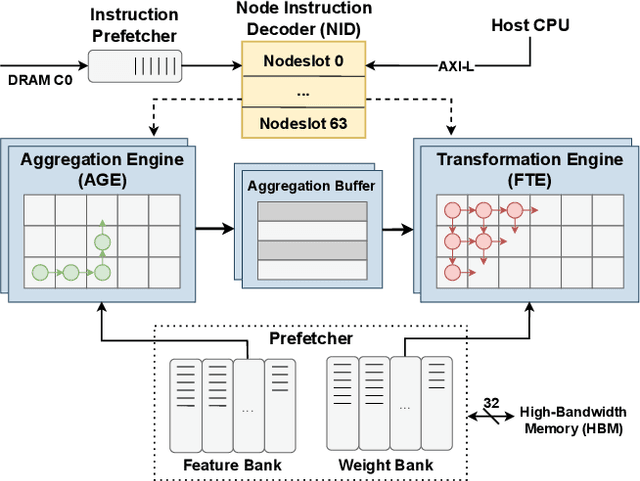


Abstract:Graph Neural Networks (GNNs) have recently gained attention due to their performance on non-Euclidean data. The use of custom hardware architectures proves particularly beneficial for GNNs due to their irregular memory access patterns, resulting from the sparse structure of graphs. However, existing FPGA accelerators are limited by their double buffering mechanism, which doesn't account for the irregular node distribution in typical graph datasets. To address this, we introduce \textbf{AMPLE} (Accelerated Message Passing Logic Engine), an FPGA accelerator leveraging a new event-driven programming flow. We develop a mixed-arithmetic architecture, enabling GNN inference to be quantized at a node-level granularity. Finally, prefetcher for data and instructions is implemented to optimize off-chip memory access and maximize node parallelism. Evaluation on citation and social media graph datasets ranging from $2$K to $700$K nodes showed a mean speedup of $243\times$ and $7.2\times$ against CPU and GPU counterparts, respectively.
Cached Multi-Lora Composition for Multi-Concept Image Generation
Feb 07, 2025Abstract:Low-Rank Adaptation (LoRA) has emerged as a widely adopted technique in text-to-image models, enabling precise rendering of multiple distinct elements, such as characters and styles, in multi-concept image generation. However, current approaches face significant challenges when composing these LoRAs for multi-concept image generation, resulting in diminished generated image quality. In this paper, we initially investigate the role of LoRAs in the denoising process through the lens of the Fourier frequency domain. Based on the hypothesis that applying multiple LoRAs could lead to "semantic conflicts", we find that certain LoRAs amplify high-frequency features such as edges and textures, whereas others mainly focus on low-frequency elements, including the overall structure and smooth color gradients. Building on these insights, we devise a frequency domain based sequencing strategy to determine the optimal order in which LoRAs should be integrated during inference. This strategy offers a methodical and generalizable solution compared to the naive integration commonly found in existing LoRA fusion techniques. To fully leverage our proposed LoRA order sequence determination method in multi-LoRA composition tasks, we introduce a novel, training-free framework, Cached Multi-LoRA (CMLoRA), designed to efficiently integrate multiple LoRAs while maintaining cohesive image generation. With its flexible backbone for multi-LoRA fusion and a non-uniform caching strategy tailored to individual LoRAs, CMLoRA has the potential to reduce semantic conflicts in LoRA composition and improve computational efficiency. Our experimental evaluations demonstrate that CMLoRA outperforms state-of-the-art training-free LoRA fusion methods by a significant margin -- it achieves an average improvement of $2.19\%$ in CLIPScore, and $11.25\%$ in MLLM win rate compared to LoraHub, LoRA Composite, and LoRA Switch.
Omni-DNA: A Unified Genomic Foundation Model for Cross-Modal and Multi-Task Learning
Feb 05, 2025



Abstract:Large Language Models (LLMs) demonstrate remarkable generalizability across diverse tasks, yet genomic foundation models (GFMs) still require separate finetuning for each downstream application, creating significant overhead as model sizes grow. Moreover, existing GFMs are constrained by rigid output formats, limiting their applicability to various genomic tasks. In this work, we revisit the transformer-based auto-regressive models and introduce Omni-DNA, a family of cross-modal multi-task models ranging from 20 million to 1 billion parameters. Our approach consists of two stages: (i) pretraining on DNA sequences with next token prediction objective, and (ii) expanding the multi-modal task-specific tokens and finetuning for multiple downstream tasks simultaneously. When evaluated on the Nucleotide Transformer and GB benchmarks, Omni-DNA achieves state-of-the-art performance on 18 out of 26 tasks. Through multi-task finetuning, Omni-DNA addresses 10 acetylation and methylation tasks at once, surpassing models trained on each task individually. Finally, we design two complex genomic tasks, DNA2Function and Needle-in-DNA, which map DNA sequences to textual functional descriptions and images, respectively, indicating Omni-DNA's cross-modal capabilities to broaden the scope of genomic applications. All the models are available through https://huggingface.co/collections/zehui127
Refining Salience-Aware Sparse Fine-Tuning Strategies for Language Models
Dec 18, 2024



Abstract:Parameter-Efficient Fine-Tuning (PEFT) has gained prominence through low-rank adaptation methods like LoRA. In this paper, we focus on sparsity-based PEFT (SPEFT), which introduces trainable sparse adaptations to the weight matrices in the model, offering greater flexibility in selecting fine-tuned parameters compared to low-rank methods. We conduct the first systematic evaluation of salience metrics for SPEFT, inspired by zero-cost NAS proxies, and identify simple gradient-based metrics is reliable, and results are on par with the best alternatives, offering both computational efficiency and robust performance. Additionally, we compare static and dynamic masking strategies, finding that static masking, which predetermines non-zero entries before training, delivers efficiency without sacrificing performance, while dynamic masking offers no substantial benefits. Across NLP tasks, a simple gradient-based, static SPEFT consistently outperforms other fine-tuning methods for LLMs, providing a simple yet effective baseline for SPEFT. Our work challenges the notion that complexity is necessary for effective PEFT. Our work is open source and available to the community at [https://github.com/0-ml/speft].
Hardware and Software Platform Inference
Nov 07, 2024



Abstract:It is now a common business practice to buy access to large language model (LLM) inference rather than self-host, because of significant upfront hardware infrastructure and energy costs. However, as a buyer, there is no mechanism to verify the authenticity of the advertised service including the serving hardware platform, e.g. that it is actually being served using an NVIDIA H100. Furthermore, there are reports suggesting that model providers may deliver models that differ slightly from the advertised ones, often to make them run on less expensive hardware. That way, a client pays premium for a capable model access on more expensive hardware, yet ends up being served by a (potentially less capable) cheaper model on cheaper hardware. In this paper we introduce \textit{\textbf{hardware and software platform inference (HSPI)}} -- a method for identifying the underlying \GPU{} architecture and software stack of a (black-box) machine learning model solely based on its input-output behavior. Our method leverages the inherent differences of various \GPU{} architectures and compilers to distinguish between different \GPU{} types and software stacks. By analyzing the numerical patterns in the model's outputs, we propose a classification framework capable of accurately identifying the \GPU{} used for model inference as well as the underlying software configuration. Our findings demonstrate the feasibility of inferring \GPU{} type from black-box models. We evaluate HSPI against models served on different real hardware and find that in a white-box setting we can distinguish between different \GPU{}s with between $83.9\%$ and $100\%$ accuracy. Even in a black-box setting we are able to achieve results that are up to three times higher than random guess accuracy.
Absorb & Escape: Overcoming Single Model Limitations in Generating Genomic Sequences
Oct 28, 2024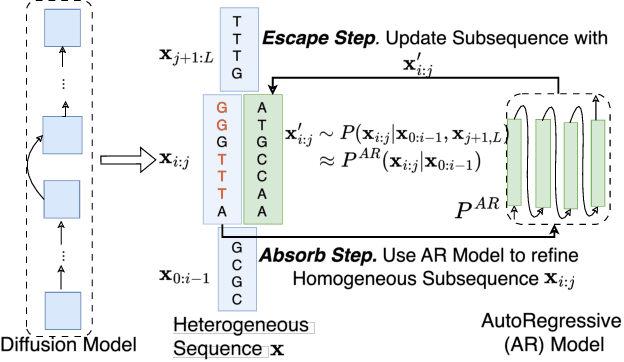


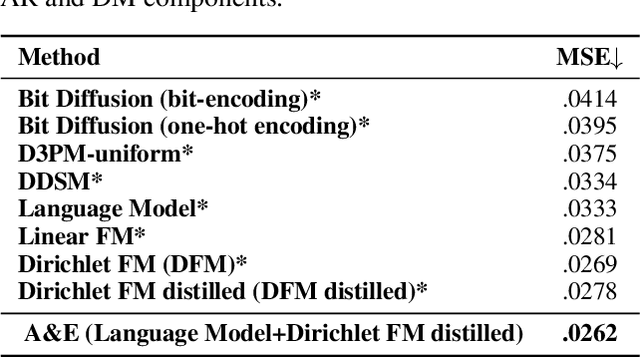
Abstract:Abstract Recent advances in immunology and synthetic biology have accelerated the development of deep generative methods for DNA sequence design. Two dominant approaches in this field are AutoRegressive (AR) models and Diffusion Models (DMs). However, genomic sequences are functionally heterogeneous, consisting of multiple connected regions (e.g., Promoter Regions, Exons, and Introns) where elements within each region come from the same probability distribution, but the overall sequence is non-homogeneous. This heterogeneous nature presents challenges for a single model to accurately generate genomic sequences. In this paper, we analyze the properties of AR models and DMs in heterogeneous genomic sequence generation, pointing out crucial limitations in both methods: (i) AR models capture the underlying distribution of data by factorizing and learning the transition probability but fail to capture the global property of DNA sequences. (ii) DMs learn to recover the global distribution but tend to produce errors at the base pair level. To overcome the limitations of both approaches, we propose a post-training sampling method, termed Absorb & Escape (A&E) to perform compositional generation from AR models and DMs. This approach starts with samples generated by DMs and refines the sample quality using an AR model through the alternation of the Absorb and Escape steps. To assess the quality of generated sequences, we conduct extensive experiments on 15 species for conditional and unconditional DNA generation. The experiment results from motif distribution, diversity checks, and genome integration tests unequivocally show that A&E outperforms state-of-the-art AR models and DMs in genomic sequence generation.
 Add to Chrome
Add to Chrome Add to Firefox
Add to Firefox Add to Edge
Add to Edge